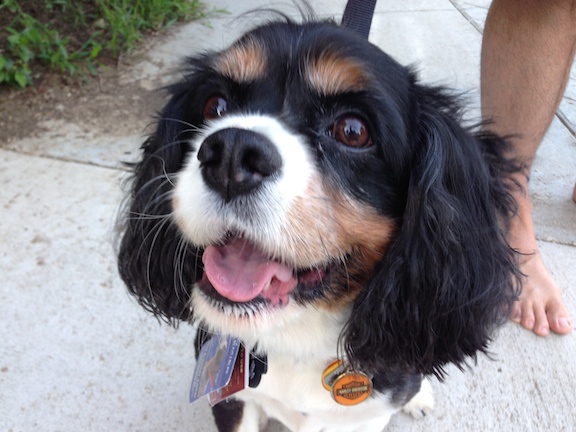Teaching a Possessive Dog its Better to Share
By: David Codr
Published Date: July 16, 2014
 Harley is a seven-year-old King Charles Caviler Spaniel with a bad case of possessive aggression.
Harley is a seven-year-old King Charles Caviler Spaniel with a bad case of possessive aggression.
Harley is owned by the older brother of a long time friend so I had met him before the session. When I met him, I got to see his possessiveness in person. He let out a long growl and while its wasn’t the most aggressive thing I had ever heard, I could tell there was some substance behind it.
When I arrived for the session, I expected to see more of the same. But the dog greeted me well and didn’t show any aggression as I sat down with his owners to discuss the situation.
During my discussion with Harley’s owners, I learned that he didn’t have any rules and that the growling had also been accompanied by some nipping.
Whenever I work with a dog that has behavioral issues, I always suggest adding rules and structure to the dog’s life to help them stop identifying themselves as a leader.
I suggested they not allow Harley on the couch or other heightened position as dogs often equate the height of their perch to their authority. I also advised them to make him sit before opening a door to let him in or out.
These may seem like inconsequential things to do, but to a dog, they have a cumulative effect.
To help redefine the leader follower dynamic, I went over a possession exercise that requires the dog to avoid a high value treat placed on the floor. It only took me one repetition to communicate the new boundaries to Harley.
I walked his owners thru the exercise until they got the same results, then advised them to repeat it a few times a day over the next few weeks. This will help the dog look to humans for guidance and permission. Crucial traits to build up for any dog with possessive tendencies.
After going for a quick walking demonstration, I showed Harley’s owners a new way to feed him. Because dogs equate their rank amongst their peers by the order in which they eat, I advised his owners to only allow Harley to eat after he see’s the humans do so.
Things started out great, but after waiting right outside the kitchen for a moment, Harley decided to barge in and get his food, permission be dammed.One of his owner’s attempted to stop him, but they hesitated when they did so which Harley interpreted as weak so he started to growl at them and refused to leave the bowl.
I stepped in and used a few pitchers sitting on the kitchen counter to block Harley’s attempt to stop me from removing him from his food. He put up a little bit of a fight before giving up and moving back out of the kitchen. For a little cute dog, Harley has one intimidating growl.
Once he was out of the kitchen, we resumed the structured feeding by having the humans eat some crackers while Harley waited. Once they were doe eating, they walked over to his bowl and make a big sweeping gesture to let Harley know he had their permission to eat his food.
Its likely that Harley will put up a little bit of a fight before giving up his perception of authority. I suggested that his owners remove any objects the dog showed possessive aggression over and also advised them to adopt the “no free lunch” methodology. By not petting or interacting with the dog unless it does something for the human like come, lay down or sit, we can help condition Harley to defer and respect to the authority of his humans.
It will be important that Harley’s owners maintain these new rules and boundaries as well as master the possessive exercise to help the dog see himself as subordinate to his owners. Combined with positive reinforcement for responding to commands and dropping items, Harley will learn that its better to share.
Categorized in: Dog Behavior, Dog Psychology, Dog trainer in omaha, Dog trainer Nebraska, Dog Training Omaha, Nebraska dog training



